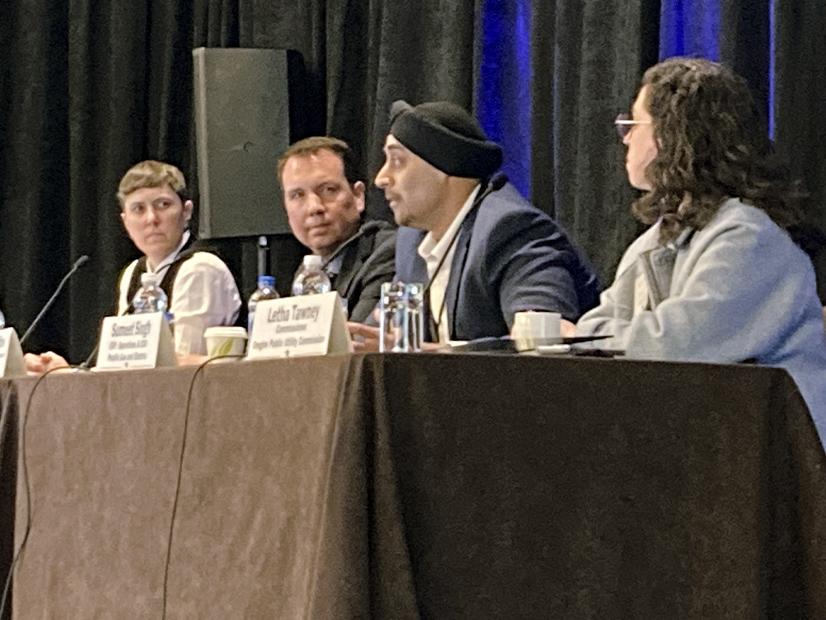
INCLINE VILLAGE, Nev. – A relatively new California agency is working to transform utilities’ wildfire safety culture by shifting away from penalties and enforcement to a proactive, learning-based approach.
The California Office of Energy Infrastructure Safety was established through state legislation following devastating wildfires in 2017 and 2018, according to Caroline Thomas Jacobs, the office’s director. The agency got its start as the Wildfire Safety Division within the California Public Utilities Commission but became a standalone department in July 2021.
The office, known as Energy Safety for short, is now about three years old.
Thomas Jacobs talked about the new initiative during a panel discussion at last week’s joint meeting of the Committee on Regional Electric Power Cooperation (CREPC) and the Western Interconnection Regional Advisory Body (WIRAB).
Energy Safety’s activities are based on a shift from “a compliance-based, reactive, penalty-enforcement approach to issues of safety to implementing a new, proactive planning-learning-improvement regulatory cycle,” Thomas Jacobs said.
Among its duties, the agency reviews utilities’ wildfire mitigation plans and assesses their safety culture each year. Wildfire mitigation plans are based on a “maturity model” in which utilities explain where they are in terms of wildfire prevention activities and where they expect to be as a result of safety investments.
In the safety culture assessment, utilities survey their employees and contractors — from frontline inspectors to senior managers — on their understanding of and approach to wildfire safety. Energy Safety then makes recommendations on how safety culture could be improved and follows up to see if the recommendations are being implemented.
But enforcement isn’t disregarded: Energy Safety also conducts inspections, audits and investigations to see whether utilities are complying with their approved wildfire mitigation plans.
Panelist Brian D’Agostino, vice president of wildfire and climate science at San Diego Gas & Electric, said the new framework is “having a real impact” on the utility’s culture and helping it maintain focus on priority safety areas.
“These safety culture assessments don’t come back and say everything’s great top-to-bottom,” D’Agostino said. “It gives us areas where we can really focus on and areas where we can improve.”
Panelist Sumeet Singh talked about how safety culture has changed at Pacific Gas and Electric, where he is executive vice president of operations and chief operating officer.
“Frankly, the wildfire risk is something that surprised PG&E,” Singh said. “One of the big reasons for the surprise was the significant drought that happened in 2014 to 2016 that completely changed the environment in which the overhead electric assets operated.”
The change was initially missed because of the utility’s focus on reliability and running assets to failure, Singh said. Now, he said, PG&E has adopted a mindset seen in high-hazard industries.
The Camp Fire, which destroyed much of the town of Paradise in November 2018 and killed more than 80 people, along with a series of Northern California wine country fires in October 2017, forced PG&E into bankruptcy and led to a multibillion-dollar settlement with fire victims.
In June 2020, the utility pleaded guilty to 84 counts of involuntary manslaughter and one count of arson in connection with the Camp Fire. In February, PG&E pleaded not guilty to 11 charges stemming from the September 2020 Zogg Fire. (See PG&E Pleads Not Guilty to Manslaughter Charges.)
Singh said that mitigations in the utility’s wildfire safety plan include plans for undergrounding 10,000 miles of distribution lines and replacing bare lines with covered conductor or insulated wire in high fire-threat areas. (See PG&E Scales Back Plan to Underground Lines.) PG&E is also turning to remote grids and microgrids in situations where a handful of customers in remote areas are served by distribution lines that run across risky terrain.
But Singh said PG&E is also working to change its safety culture. One goal is to make sure that employees who know the assets feel empowered to speak up if they spot a problem, he said.
Another issue has been the different perception of risk among employees ranging from inspectors to supervisors and executive leadership. The focus now is to “align on the perception of risk,” Singh said.
He gave as an example an employee who has been working on electric systems for a long time.
“They may have been OK at one point in time to look at [an] adverse condition in the health of a tree and say, you know what, we can actually remove or address that in six months,” Singh said. “That’s not the case anymore. That’s an immediate safety issue that actually needs to be addressed right away.”
